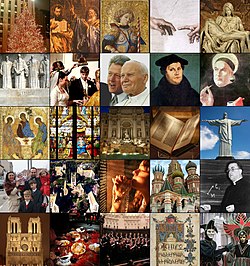
Back Liturgiese jaar Afrikaans Kirchenjahr ALS أعياد مسيحية Arabic اعياد مسيحيه ARZ Any litúrgic Catalan Liturgický rok Czech Calendr litwrgïaidd Welsh Kirkeåret Danish Kirchenjahr German Liturgia jaro Esperanto
| Part of a series on |
| Christian culture |
|---|
 |
| Christianity portal |
| Part of a series on the |
| Catholic Church |
|---|
 |
| Overview |
|
|
The liturgical year, also called the church year, Christian year, ecclesiastical calendar, or kalendar,[1][2] consists of the cycle of liturgical days and seasons that determines when feast days, including celebrations of saints, are to be observed, and which portions of scripture are to be read.[3]
Distinct liturgical colours may be used in connection with different seasons of the liturgical year. The dates of the festivals vary somewhat among the different churches, although the sequence and logic is largely the same.
- ^ "Definition of KALENDAR". Merriam-Webster. Retrieved April 27, 2021.
—used especially of ecclesiastical calendars // the Episcopal kalendar
- ^ "Kalendar". Anglican Catholic Church. 2015. Retrieved May 23, 2015.
It is as a result of this connection that "kalendar/calendar" came to refer to the orderly arrangement of time as we now know it, but the established church retained the older "K" spelling to distinguish their kalendar from an ordinary list of events. In other words, a kalendar is simply a church calendar!
- ^ John Dowden (1910). The Church Year and Kalendar. Cambridge University Press. p. xi.
The Church's Year, as it has been known for many centuries throughout Christendom, is characterised first, by the weekly festival of the Lord's Day (a feature which dates from the dawn of the Church's life and the age of the Apostles) and, secondly, by the annual recurrence of fasts and festivals, of certain days and certain seasons of religious observance. These latter emerged, and came to find places in the Kalendar at various times.